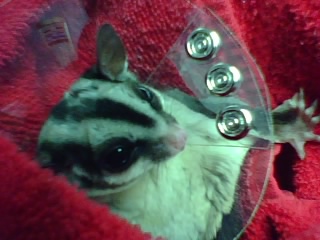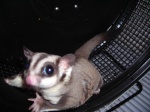 | The Sweet Spot
INFORMATION concerning sugar glider health and husbandry matters
|
|
| | The SUGAR Group's Necropsy Studies |  |
| | | Author | Message |
|---|
The SUGAR Group
Registered Non-Profit

Posts : 118
Join date : 2010-04-10
 |  Subject: The SUGAR Group's Necropsy Studies Subject: The SUGAR Group's Necropsy Studies  Wed Aug 11, 2010 8:12 pm Wed Aug 11, 2010 8:12 pm | |
| Necropsies are an incredibly important learning tool. Through their results, the owner can learn why their pet died. In homes with multiple gliders, this can reassure them that their other pets are not in danger. Answers can provide peace of mind. When those results are shared, glider owners as a whole can learn if our current caretaking methods are adequate. Often times, necropsy results cause us to question ways to care for our gliders better. Necropsies encourage learning. The key is in consolidating the information. Generalized conclusions can’t be drawn from one or two necropsy reports. We need as many results, from as many different homes, as possible. The Necropsy Effort is a project of the SUGAR Group. The goals of the Necropsy Effort are: 1) To collect scientific data on sugar glider anatomy, death and physiology through the collection and analysis of necropsy reports and a necropsy survey. When the SURVEY is combined with the necropsy report, the picture becomes even more clear. We are afforded a great deal of additional information by matching necropsy results with the survey. This is one of the methodologies that causes the SUGAR Group’s research to stand out and makes our research unique. 2) To encourage owners to consider having a necropsy (and histopathology) any time one of their beloved gliders passes away by reimbursing a portion of the cost of the procedure(s) for anyone who completes our survey AND provides us with a copy of the reports. The SUGAR Group has a working relationship with a pathologist and we are able to match the owner’s cost. For a necropsy AND histopathology, the owner’s cost would be $50.00. All reports are then sent to the SUGAR Group and entered into our database for future study. All results are stored in 3 different places so that they are never lost to this community. Owners who wish to take advantage of this, may contact the SUGAR group through our website http://www.sugargroup.org. You may also participate in the study by sending in necropsy reports from past necropsies. We learn from each and every necropsy performed. Collectively, these reports are helping us to put together a comprehensive picture and to make recommendations for treatment. Even more significant to owners is that the necropsy reports in combination with the surveys are helping us to put together a list of symptoms that one might see BEFORE a glider becomes terminally ill, so that perhaps we can begin to treat some of these conditions and prolong the healthy lives of our gliders. This is an important project, and one that is very near to the hearts of many. For more information on The SUGAR Group and its projects, visit their website! | |
|   | | The SUGAR Group
Registered Non-Profit

Posts : 118
Join date : 2010-04-10
 |  Subject: Re: The SUGAR Group's Necropsy Studies Subject: Re: The SUGAR Group's Necropsy Studies  Wed Nov 24, 2010 8:24 pm Wed Nov 24, 2010 8:24 pm | |
| The Necropsy Effort is a project of the SUGAR Group.
The goals of the necropsy effort are:
1) To collect scientific data on sugar glider anatomy, death and physiology through the collection and analysis of necropsy reports and a necropsy survey. These combined reports (survey and pathology report) will allow us to identify trends and commonalities in disease processes and begin to make changes which will decrease the frequency of such disease processes.
2) To encourage owners to consider having a necropsy (and histopathology) any time one of their beloved gliders passes away by reimbursing a portion of the cost of the procedure(s) for anyone who completes our survey AND provides us with a copy of the reports.
We learn from each and every necropsy performed. Collectively, these reports are helping us to put together a comprehensive picture and to make recommendations for treatment. Even more significant to owners is that the necropsy reports in combination with the surveys are helping us to put together a list of symptoms that one might see BEFORE a glider becomes terminally ill, so that perhaps we can begin to treat some of these conditions and prolong the healthy lives of our gliders. This is an important project, and one that is very near to my heart.
To receive reimbursement from The Necropsy Effort:
1) Notify Val that you wish to receive reimbursement. She will let you know at that time if we have funds available. You may notify her through PM or through the contact form on the SUGAR Group's website.
2) If funds are available, they will be earmarked for you and set aside. You have your necropsy and/or histopathology completed and await the report OR you ship your glider to Val to have the necropsy and histopathology completed at our lab.
3) In the mean time, complete our necropsy survey.
4) When you receive your written report, forward a copy to the SUGAR group with your survey.
5) Once we have BOTH your report (both reports if you are seeking reimbursement for both a necropsy and histopath) AND the completed necropsy survey, then we will approve you for reimbursement.
6) We will forward reimbursement to your paypal address within 3 weeks of approval.
You CAN participate in the project even if you do not wish to have reimbursement. You can provide us a copy of your report and complete our necropsy survey ANY" time. We even welcome necropsy reports from months or years ago. EVERY one helps the effort.
Surveys and necropsy reports can be sent to
Val Betts
c/o The SUGAR Group
604 Deahl Street
Borger, TX 79007
Reimbursement rates are as follows
Necropsy ONLY - $25
Necropsy + Histopathology - $50
We will continue to offer reimbursement as long as funds are available. Funds become available when donations are made, and through projects such as the RRRoundup's raffle and other fund-raising events throughout the year. The SUGAR group appreciates the support of ALL who participate through completing surveys, sharing lab reports, telling others of the SUGAR group, creating educational materials for our programs, making donations and attending the RRRoundup in March. | |
|   | | thefotokat

Posts : 375
Join date : 2010-01-01
 |  Subject: Re: The SUGAR Group's Necropsy Studies Subject: Re: The SUGAR Group's Necropsy Studies  Wed Nov 24, 2010 10:34 pm Wed Nov 24, 2010 10:34 pm | |
| This seems like a good time to reiterate the benefits of necropsies.
Necropsies are pieces of a puzzle. When viewed alone, they do not give instant solutions. They provide answers to some questions and, hopefully, they lead us to ask more questions. To find answers to these questions, more research is done. The results of this research give us more pieces to the puzzle. Looking at any one piece of the puzzle provides clues, but the picture only begins to emerge when the pieces are put together. Assembling the puzzle doesn’t happen quickly. Each piece must be studied and placed correctly. Assumptions as to the end result must be put aside. Just because the pieces are black and white doesn’t mean they’re going to show you a picture of a zebra. Penguins and dalmatians can’t be ruled out.
So who helps put these pieces together? It’s a combined effort of several people. First, the owner observes the glider. They see a change in behavior or symptoms of illness. Their concerns are taken to the veterinarian who examines the glider, runs tests and develops a diagnosis and treatment regimen. When that treatment is not successful, the pathologist steps in. Unlike the veterinarian, who treats the living, the pathologist studies the dead. By reading the veterinarian’s notes and examining the glider’s body, organs, and tissue, the pathologist forms a conclusion: the cause of death. This report is sent to the veterinarian who relays the findings to the owner. The research groups, like the SUGAR Group, collect this data from numerous owners, veterinarians and pathologists and track findings. Commonalities are noted and directions for further research are mapped out. The pieces are put together, and a picture becomes clearer. By studying the information provided, we can begin to determine if our black and white pieces have spots, stripes or patches.
In today’s medical field, amazing accomplishments have been achieved. Doctors are performing microsurgeries on the brain, replacing worn out hips and knees with artificial ones and transplanting hearts and kidneys. Conditions that were untreatable 20 years ago are now viewed as routine procedures. How did this happen? Doctors put together the puzzle. The orthopedic surgeon replacing your grandmother’s hip knows how to do so because the human body has been studied over the years. Xrays, bloodwork, ultrasounds…and autopsies. Results of all this research was combined and medical breakthroughs were discovered. The puzzle pieces were assembled.
The research that is being performed in today’s sugar gliders will allow us to make changes resulting in better care for the sugar gliders of tomorrow. It would be wonderful if we could perform a necropsy and find a note inside that told us how to immediately prevent another glider’s death, but that is not a reality. We can’t rush the puzzle or we risk failure and even harm. Imagine if you had back pain. You have a choice of 2 doctors. One says “I just saw a patient with your same symptoms. They had a tumor. We have to operate”. The second doctor says, “Tell me about your symptoms. What were you doing before the pain started? Does anything make the pain worse? Let’s take some xrays and draw blood.” You tell the doctor that you’ve been feeling tired and have a hard time catching your breath. Sometimes your arm hurts, too. The tests come back and show an elevated level of troponin and phosphokinase. Nothing out of the ordinary is found on the xray. This doctor sends you to a cardiologist who finds that you’ve suffered a mild heart attack. You’re placed on medication, your symptoms fade and you are able to resume your life. Which doctor would you choose: the first one who was sure they saw a zebra or the second one who took the time to put the pieces together to find the penguin? If you chose the second doctor, how do you think he gained the knowledge of what tests to run for your symptoms? The answer is years of research. Autopsies performed on 100 people who shared your symptoms showed damage to the heart in 95 cases. Those autopsy results didn’t help the first, second or even third person who suffered this problem…but it did help you.
In order to make progress, we must set our sights on the future. We must use the past and the present to make that future a brighter one.
| |
|   | | Usha77
MENTOR

Posts : 1808
Join date : 2009-12-13
Age : 47
Location : Greeley, CO
 |  Subject: Re: The SUGAR Group's Necropsy Studies Subject: Re: The SUGAR Group's Necropsy Studies  Wed Nov 24, 2010 10:49 pm Wed Nov 24, 2010 10:49 pm | |
| | |
|   | | Something_To_Believe_In
Associate

Posts : 4565
Join date : 2009-12-10
Age : 51
Location : Texas
 |  Subject: Re: The SUGAR Group's Necropsy Studies Subject: Re: The SUGAR Group's Necropsy Studies  Fri Nov 26, 2010 10:07 pm Fri Nov 26, 2010 10:07 pm | |
| Thank you for posting that Kate.
If we all expected immediate answers, we would never be anywhere. I just this week attended training on a different treatment for 1st degree burns. This is different than the way our ER had been treating them, but we now know a better way because of RESEARCH. Years of it. No, it did not help the burn victims who were studied, but it is helping people today.
This is the goal of the SUGAR Group. We know we don't have many answers right now, but one day we will. | |
|   | | Something_To_Believe_In
Associate

Posts : 4565
Join date : 2009-12-10
Age : 51
Location : Texas
 |  Subject: Re: The SUGAR Group's Necropsy Studies Subject: Re: The SUGAR Group's Necropsy Studies  Sun Jan 02, 2011 2:20 pm Sun Jan 02, 2011 2:20 pm | |
| I also wanted to take a moment to remind us all that SOMETIMES we WILL get answers from a necropsy that will help our remaining gliders.
Two recent examples:
#1 - A necropsy found that the glider died of aflatoxin poisoning, which was a shock to this well educated member of this online community. So, she (the owner) began having things in her home tested. She was able to locate the source of the aflatoxin as a bad batch of an ingredient she used in her diet, and was able to eliminate it from her home and save her remaining gliders from ingesting it any more.
#2 - It is through two necropsies that I began to understand just how contagious and devestating periodontal disease is. Prior to this, I had never seen any talk on any of the boards of periodontal disease being contagious. I now know it is and to treat it aggressively and to remove any glider diagnosed with it from his/her cage mates. This has prevented further outbreaks in my home.
So, even though we are using all of these reports together to create an overall picture, and even though most of the time the results will not give you answers for your surviving gliders, there ARE times when we can learn and make immediate adjustments to our treatment of our gliders in order to positively impact the lives of the surviving gliders.
I hate to think what might have happened at the home of the person in example #1 if she had NOT gotten the necropsy/histopathology. If she had thought "they don't do me any good anyhow" or "They don't help my other gliders at all" and, therefore, had not gotten one done, she could have lost ALL of her gliders.
Necropsies are a good thing - no matter what.
| |
|   | | Sponsored content
 |  Subject: Re: The SUGAR Group's Necropsy Studies Subject: Re: The SUGAR Group's Necropsy Studies  | |
| |
|   | | | | The SUGAR Group's Necropsy Studies |  |
|
Similar topics |  |
|
| | Permissions in this forum: | You cannot reply to topics in this forum
| |
| |
| |
|
